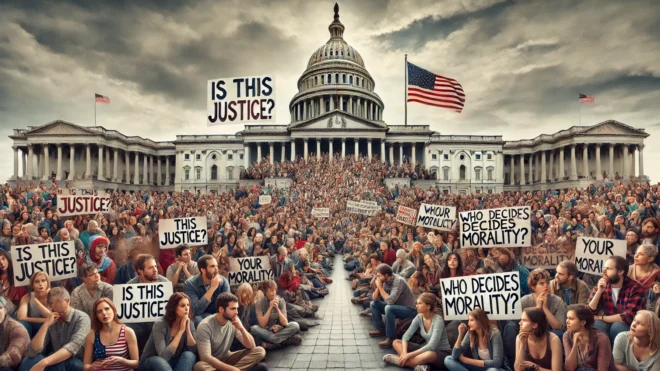We have repeated Francis Schaeffer’s warning about ‘personal peace and affluence’ often at Blue Kennel, but it’s time to do it again. He declared, back about 1970, that the ‘Silent Majority’, a term Nixon had begun to use, was composed of two parts; a minority within the Silent Majority that was either Christian or had a strong Christian memory, and a majority of the Silent Majority which had only two ultimate values, which he called affluence and personal peace. [‘Personal peace’ has nothing to do with pacifism, but it is connected, I think, to the ‘freedom from speech’ and other ‘freedom from’ movements of our day.] And if freedom or justice conflicted with these values, freedom and justice would have to take a back seat.
Many Christians, especially large parts of the ‘religious right’ which emerged at the end of the 1970s, failed to heed this warning. One can argue that Schaeffer himself, in his last years, failed to pay attention to it. His contribution to the ‘religious right’ was to raise the issues of abortion and euthanasia, most especially in his project Whatever Happened to the Human Race, recruiting evangelical Protestants to issues that they had previously tended to regard as Roman Catholic obsessions.
The Religious Right had a lot of appeal to sincere Christians, but many of their ideas appealed also to the less discipled whites who were nominal evangelicals, rarely went to church, and were motivated by fear of the Other; such people feared homosexuals, along with nonwhites and immigrants, as part of the Other; ‘prayer in public school’ in the belief that somehow this would keep kids in line [I doubt this!], and to the extent they opposed abortion, it was more about cracking down on the Sexual Revolution and loose women [also part of the Other] than a compassion for the unborn and their mothers in a crisis pregnancy. [There was, the whole time, also a Secular Right that supported abortion and contraception for the poor and unfit, to keep them from breeding, and invoked ecological considerations to justify this. They did not have much of a public presence until the Internet, but they have been with us much longer. As Allan C. Carlson informs us in The American Way, before 1964 the Democrats were the ‘family wage’ party and the Republicans were the party of Planned Parenthood and of opportunity for working women.]
The leaders of the Conservative Movement, and also the activists of the slightly different Religious Right, are sincere believers in their doctrines, far from having any kind of a racist ideology, but as Zack Beauchamp quotes scholar Avik Roy,
Conservative intellectuals, and conservative politicians, have been in kind of a bubble . . . We’ve had this view that the voters were with us on conservatism – philosophical, economic conservatism. In reality, the gravitational center of the Republican party is white nationalism.
I think the Religious Right, with a few exceptions, made a very similar error. The results of the Proposition 8 election in California should have turned the Religious Right totally against white nationalism. Of the four major ethnic groups in California in November 2008, the stronger Obama ran, the stronger Proposition 8 ran. My wife raised this point to a leading traditional marriage advocate and was told “Oh, this couldn’t possibly be true!” If you eliminate those that are primarily motivated by Fear of the Other, the Religious Right turns out to be not very big. On the other hand, it reveals that if partisan [Republican vs Democrat] issues are taken out of the picture, the social conservatism of Blacks and Latinos can become a force.
I have already posted on Michael Lind’s paper of 2014 [before the rise of Trump] predicting a new alignment after the disappearance of social conservatism; the Densitarian-Liberaltarian, supporting means tested welfare, vs the Posturbian – Populiberal, favoring ‘earned’ welfare programs for all. The reader may review this.
Going forward, those who support the issues that are still in play, such as the life issues, have a difficult row to hoe, but they have the benefit of no longer being wedded to one political party or one side in our cultural divisions, and can and should go forward from here as bipartisan or nonpartisan, as they should have done all along.




